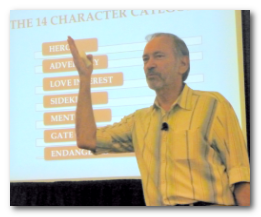The 4 Emotions In Screenplay Writing
Hello Writers All,
The first moment it hits you that you might want to write a screenplay, you quickly realize it’s time to get busy learning the elements of screen story structure, character, and scene development.
Understanding these concepts is essential for the job. But also, never forget the one basic reason why so many millions of people all over the world love to go to the movies: a good film story sweeps us all into an experience of FEELING DEEPLY.
Creating a terrific screenplay or novel comes down to a writer’s ability to build, then orchestrate, strong human emotion throughout the story.
There’s a huge range of emotion present in all fine screenplay writing, of course, but DON’T let that seeming complexity discourage you. Understanding how to use emotion to keep your script driving ever onward toward a satisfying ending can be a lot simpler than you think if you have the right tools on hand.
And I’ve got a great one for you!
DOWNLOAD 4 EMOTIONS INFOGRAPHIC BELOW
When writing for screenplay success, whatever your story may be, you need to begin by creating an emotional bond between your audience and the protagonist. Drawing an audience into caring about your hero by page two is good — by page one is better!
If your heroine or hero has been introduced at the very start of your story as possessing empathy-creating qualities, your audience will project themselves emotionally into the protagonist. Now they really care what happens to the hero. Now your audience steps eagerly into the roller-coaster car that is your story, and they’re ready to share all the deep feelings your protagonist will experience in the journey ahead.
Audiences, in fact, insist you sweep them along on an ever evolving emotional ride, and bonding them to your hero is a super important first step. Next, it’s how you orchestrate the rising and falling tempos of emotional conflict between your characters in each and every scene that allows your audience to not just watch the plot action, but to truly live the story.
The physical dramatic action you write needs to be constructed so as to create the flow and swirl of emotion you want expressed in each scene.
Ask yourself, “What emotion will my hero be feeling as she or he enters this next scene?” Make a clear choice here, because the feelings of the other characters in a scene you’re about to write will develop from whatever emotion the protagonist brings into it when the scene begins.
Then… the way you guarantee conflict in every scene is to MAKE SURE YOUR HERO ENDS THAT SCENE WRAPPED UP IN A COMPLETELY DIFFERENT EMOTION than the one they started with.
CHANGE is the dramatic engine that makes screenplays work. If nothing changes emotionally in a scene—and I mean in every single scene—then the writer still has work to do.
The Four Key Emotions
I’m about to say something you may think strange. Something that, well, might actually tick you off a bit. I only ask that you hear me out.
And it’s this: There are only four categories of emotion that work well in screenwriting. Those four are: MAD, SAD, GLAD and SCARED.
“Oh Eric, that’s ridiculous!” you may grumble. “Any writer can come up with hundreds, maybe thousands of other emotions!”
Think so? Okay then, go ahead—write some down. Scribble down as many different kinds of emotion as you can think of. Then… take a very close look at your list.
What I’ve found is that the slew of other emotions you can name, in truth, are just variations and shadings of feelings that all fit into these four main categories.
A character feeling MAD can be experiencing a range of emotion from slightly irked to seethingly homicidal—but it’s all still about feeling some degree of MAD. A person who is SCARED can experience emotion in a range stretching from a wee bit worried to utterly horrified. Take love. Now there’s an emotion with some pretty wild variations to it. But at their core, ALL types of love, from puppy-love to the eternal ever-after kind to the purely platonic type, all really fit into the GLAD category.
And this simplified concept of emotion “categories” can be a very powerful tool for writers.
When you sit down to write your next scene, try this:
- If your hero enters a scene SAD, she must exit that scene somewhere in the MAD, GLAD, or SCARED categories.
- If your protagonist launches a scene feeling GLAD, just be sure he ends that scene in the range of SCARED, SAD, or MAD.
This gives you a simple test to insure your scenes will create and develop rising conflict—and it guarantees that your scenes will go somewhere, build to something, draw your audience ever deeper into the story.
This little tool can ensure that EVERY SCENE YOU WRITE WILL CONTAIN DRAMATIC, EMOTIONAL, STORY-DRIVING CHANGE. And in all types of narrative writing, meaningful CHANGE is the whole ballgame.
But remember, too, of course, that this “Four Emotion Categories” thing is just another outlining tool. It doesn’t let you off the hook as a writer!
To be able to create believable emotional conflict between your characters, you must work ceaselessly to understand the personality makeup of every character in your screenplay or novel: their hopes, wounds, predominant attitudes. And that means we writers need to get in touch with our OWN emotions to make sense of, and portray well, those inner struggles every person alive must labor through.
Dear writer, know thyself.
Easy to say, not so easy to do. This job lasts a lifetime. But it’s a big part of what makes our craft of writing screenplays and novels so-o-o darned rewarding.
Think I’m nuts about this emotion categories thing?
TRY IT!
Pick a scene from your favorite movie and name the emotion it starts with.
Now, did it change to another dominant emotion by the end of the scene?
Let us know your thoughts in the comment box below.
My deepest good wishes to you all!
p.s. Be sure to visit my website at https://www.thestorysolution.com to download complimentary film structure breakdowns for Back to the Future, Bridesmaids, and Finding Nemo. (And more breakdowns are on the way!)
About The Story Solution: Eric Edson’s The Story Solution provides concrete insights for writing a screenplay. Regarded as one of the best books on screenwriting, The Story Solution is currently #1 in its category on Amazon China. Visit the website at https://www.thestorysolution.com to download a complimentary book chapter, view video clips of Eric’s interview with FILM COURAGE, and subscribe to Eric’s podcast. “Like” the Facebook page to receive tips on novel writing and scriptwriting. The Story Solution is a proud partner with Final Draft and Eric’s revolutionary “Hero Goal Sequences” structure paradigm is now included as an EDU download in Final Draft 10 & 11.












Hello
I have written the first draft of a screenplay based on my original idea and I’ve sought feedback from a a couple of professionals in the field. They have given me useful notes which I’m using to rewrite my screenplay which I realize needs work to be done.
Eric Edson’s lectures and his book which I’ve ordered will no doubt serve me well.
Thanks
cheers Vijay
Could u please take a one scene content teach me how to write the four key emotions in a scene.